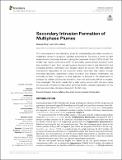Secondary Intrusion Formation of Multiphase Plumes
Author(s)
Wang, Dayang; Adams, E. Eric
Downloadfmars-08-617074.pdf (1.886Mb)
Publisher with Creative Commons License
Publisher with Creative Commons License
Creative Commons Attribution
Terms of use
Metadata
Show full item recordAbstract
<jats:p>This work presents a new laboratory study for understanding secondary intrusions in multiphase plumes in quiescent, stratified environments. The study is driven by field observations of secondary intrusions during the Deepwater Horizon (DWH) oil spill. The smaller trap heights observed at DWH for secondary versus primary intrusions could have resulted, in part, from decreasing plume buoyancy (due to gas dissolution) and increasing ambient stratification with elevation above the source. We seek additional mechanisms responsible for the observed smaller secondary trap heights through controlled laboratory experiments where buoyancy and ambient stratification are nominally constant throughout. A novel approach is adopted in the experiments to increase the visibility of secondary intrusions, which are traditionally difficult to visualize, thus investigate. The study reveals that a wider plume source width can also cause the secondary intrusions to trap earlier, providing another plausible explanation for the shallower secondary intrusions observed in the field data.</jats:p>
Date issued
2021-10Department
Massachusetts Institute of Technology. Department of Civil and Environmental EngineeringPublisher
Frontiers Media SA
Citation
Wang, Dayang and Adams, E. Eric. 2021. "Secondary Intrusion Formation of Multiphase Plumes." 8.
Version: Final published version
ISSN
2296-7745